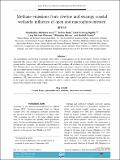| dc.description.abstract | he atmospheric concentration of methane (CH4) exerts a strong influence on the global climate. Notably, wetlands are important CH4 sources, whose emission represents an ecosystem process depending on such wetland characteristics as organic matter, temperature, pH, methanogenesis and CH4 oxidation, all of which vary on the basis of the type of wetland. Methane fluxes were investigated in a preliminary study in the region, using the chamber method in the open water and macrophyte‐infested wetlands of swampy and riverine types in Kilifi, a coastal district in Kenya, Africa. Despite a lack of significant interactions, the macrophyte‐infested areas emitted the highest quantity of methane of about 21.96 ± 0.04 mg CH4 m−2 day−1, compared with the water areas that emitted about 19.35 ± 0.05 mg CH4 m−2 day−1. The preliminary CH4 fluxes measured in this study are below the range reported from previous wetland field experiments in the tropics and temperate regions, indicating the need to conduct a series of similar experiments to produce more precise total estimates in the entire region. | en_US |

